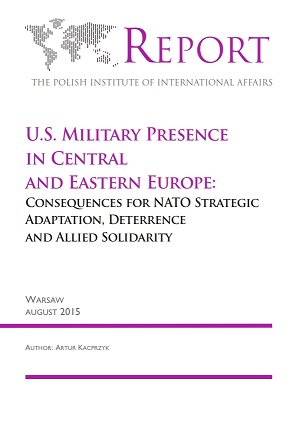U.S. Military Presence in Central and Eastern Europe: Consequences for NATO Strategic Adaptation, Deterrence and Allied Solidarity
U.S. Military Presence in Central and Eastern Europe: Consequences for NATO Strategic Adaptation, Deterrence and Allied Solidarity
Author(s): Artur Kacprzyk
Contributor(s): Dorota Dołęgowska (Editor), Anthony Casey (Editor)
Subject(s): Politics / Political Sciences, Politics, Governance, International relations/trade, Security and defense, Military policy, Geopolitics, Peace and Conflict Studies
Published by: PISM Polski Instytut Spraw Międzynarodowych
Keywords: United States of America; US military presence; Central and Eastern Europe; NATO; Ukrainian conflict; Russia; security; military policy;
Summary/Abstract: In the wake of the Ukraine conflict and Russian hostility towards NATO, the United States has proven to be the most resolute and capable Ally of the Central and Eastern European (CEE) states. The U.S. has been striving to provide leadership for the Alliance and invigorate other members to act, while implementing deterrence and reassurance measures on faster and on bigger scale than other countries. U.S. activities in CEE have included persistent rotational presence of small land forces, air and naval deployments to the region, intense training and exercises, unprecedented pre-positioning of heavy armour in the region, and improvements to local infrastructure. The U.S. has acted both bilaterally and multilaterally, as well as within the framework of NATO’s joint Readiness Action Plan (RAP). U.S. actions have been received very warmly among CEE countries, which are concerned about Russia’s behaviour and especially interested in the support and presence of the leading and most powerful member of the Alliance. Nevertheless, for Poland and the Baltic States, the permanent basing of Allied combat forces is a priority. It is necessary to send a strong political signal to Moscow, and prove that there are no second-class security guarantees for new NATO members. The intention is also to deny Russia hopes of achieving a quick victory and presenting the U.S. and the Alliance with a fait accompli. At the very least, small permanent forces would ensure that even a successful attack against CEE states would automatically result in a costly conflict with the U.S. and NATO. At the other end of the scale, bigger deployments would slow down an enemy offensive and buy time for reinforcements to arrive.
Series: PISM Reports
- E-ISBN-13: 978-83-64895-51-7
- Page Count: 23
- Publication Year: 2015
- Language: English
- eBook-PDF
- Introduction
- Table of Content

